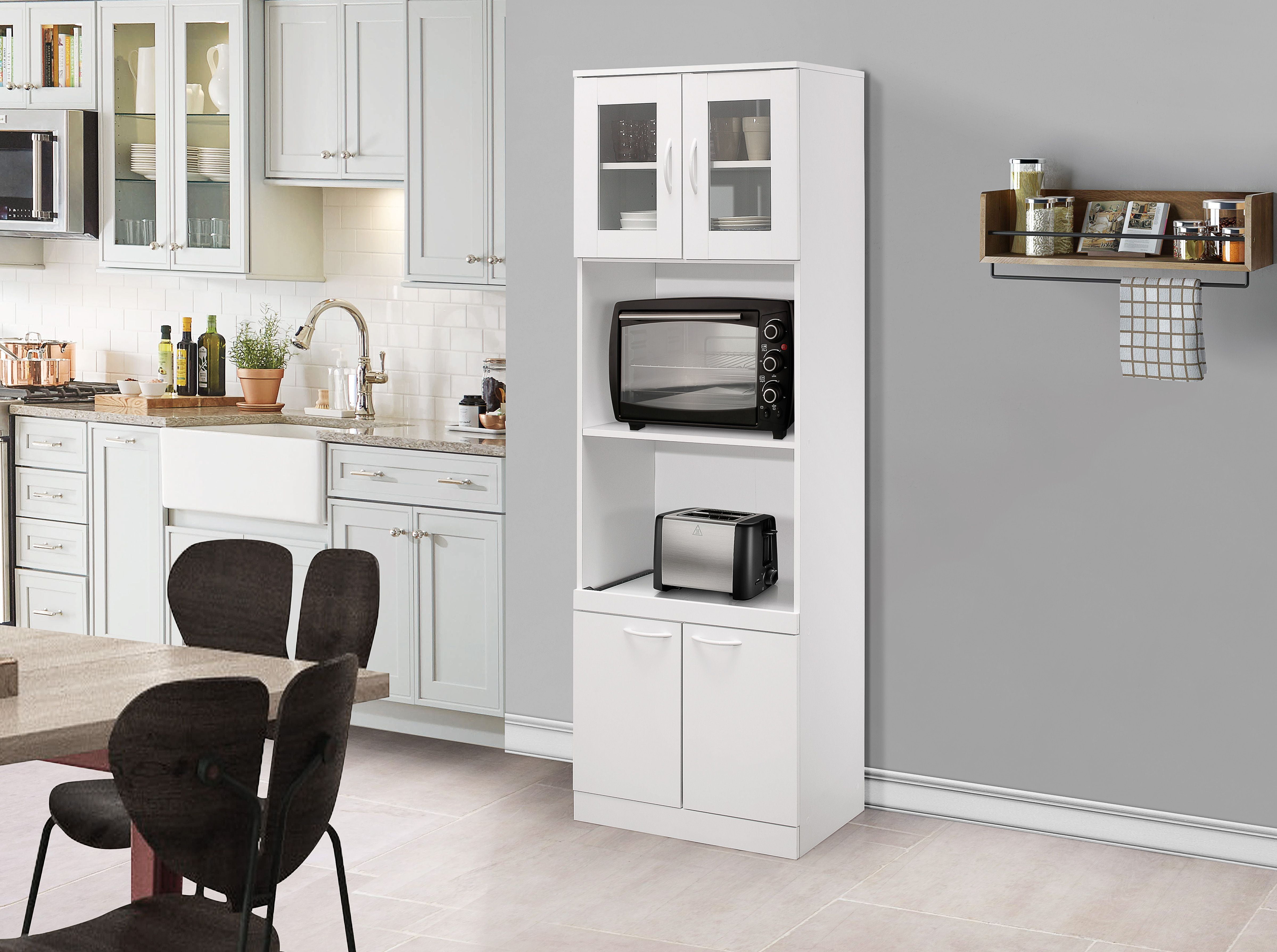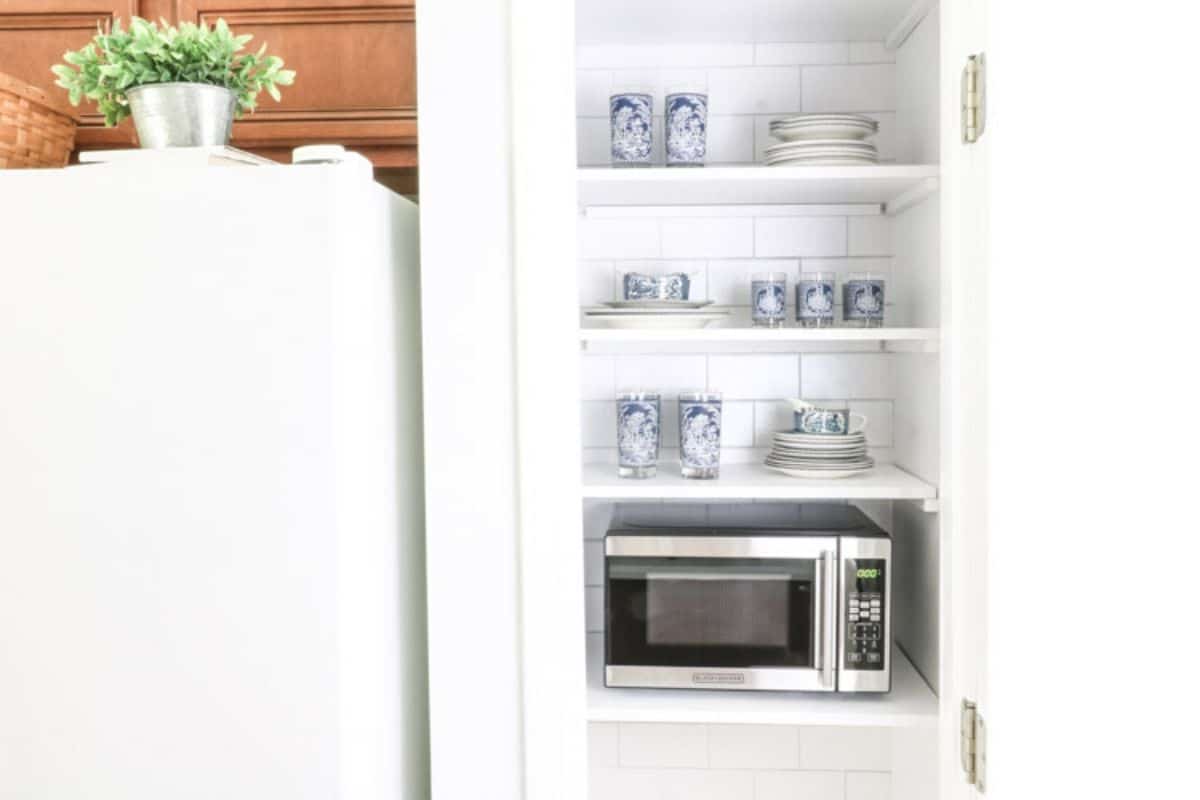Microwave Safety in Pantry Cabinets: Microwave In Pantry Cabinet

Placing a microwave in a pantry cabinet, while seemingly convenient, can pose significant safety risks if not done correctly. The confined space can lead to overheating, fire hazards, and ventilation issues. Understanding these risks and taking necessary precautions is crucial to ensure safe operation.
Ventilation and Clearance
Adequate ventilation is paramount to prevent overheating and potential fire hazards. The microwave’s heat needs to dissipate properly, and insufficient airflow can lead to a build-up of heat, potentially causing damage to the appliance or even igniting flammable materials in the pantry.
- Maintain a minimum clearance of at least 6 inches around the microwave to allow for proper air circulation. This space allows for heat dissipation and prevents the microwave from overheating.
- Avoid placing the microwave directly against a wall or other objects, as this can obstruct airflow and lead to overheating.
- Ensure the pantry cabinet has sufficient ventilation, such as vents or openings, to allow for proper airflow. If the cabinet lacks adequate ventilation, consider installing a vent fan or modifying the cabinet to improve airflow.
Electrical Safety
Proper electrical wiring and grounding are essential for the safe operation of any appliance, including microwaves. A faulty electrical connection can lead to overheating, electrical shock, or even fire.
- Ensure the electrical outlet used for the microwave is properly wired and grounded. This is crucial to prevent electrical shocks and ensure the microwave operates safely.
- Check the microwave’s power cord for any damage or fraying. Replace the cord immediately if you find any signs of damage.
- Avoid overloading the electrical circuit by plugging in other appliances on the same circuit. This can lead to overheating and electrical hazards.
Fire Hazards
Flammable materials in a pantry cabinet, such as paper towels, napkins, or food packaging, can pose a fire hazard if exposed to excessive heat from the microwave.
- Keep flammable materials away from the microwave and avoid placing them directly on top of or near the appliance.
- Ensure the microwave is properly ventilated to prevent heat buildup and minimize the risk of igniting flammable materials.
- Always supervise the microwave while it is in operation, especially when heating flammable materials.
Space Considerations and Design

Integrating a microwave into a pantry cabinet presents a unique set of design considerations that impact both functionality and aesthetics. This section explores the advantages and disadvantages of this approach, along with potential design challenges and strategies for optimizing space utilization.
Space Utilization and Accessibility
The decision to incorporate a microwave into a pantry cabinet hinges on a careful assessment of space utilization and accessibility. Here’s a comparison of the pros and cons:
- Pros:
- Maximizes Countertop Space: Moving the microwave from the countertop frees up valuable space for food preparation and other kitchen tasks.
- Concealed Storage: A pantry cabinet provides a dedicated and concealed space for the microwave, enhancing the overall aesthetic appeal of the kitchen.
- Organized Storage: Integrating the microwave into the pantry cabinet promotes a more organized kitchen environment, eliminating clutter on countertops.
- Cons:
- Accessibility: Accessing the microwave within a pantry cabinet may require bending or reaching, potentially posing a challenge for individuals with limited mobility.
- Limited Countertop Space: The decision to store the microwave in a pantry cabinet assumes sufficient countertop space for food preparation and other tasks. If countertop space is limited, this approach may not be ideal.
- Ventilation: Proper ventilation is crucial to prevent overheating and potential safety hazards. A well-ventilated pantry cabinet is essential to ensure safe microwave operation.
Design Challenges and Solutions
Incorporating a microwave into a pantry cabinet presents a few design challenges:
- Shelving Requirements: The microwave’s dimensions necessitate specialized shelving that can accommodate its size and weight. Standard pantry shelves may not be suitable.
- Electrical Wiring: A dedicated electrical outlet is required within the pantry cabinet to power the microwave. This may necessitate modifications to the existing electrical system.
- Door Clearance: Ensure sufficient clearance between the microwave and the pantry door to prevent interference during operation and access.
Maximizing Space and Layout Optimization, Microwave in pantry cabinet
To maximize space utilization and optimize the layout of a pantry cabinet with a microwave, consider the following strategies:
- Vertical Space: Utilize vertical space effectively by installing shelves above and below the microwave to accommodate other pantry items.
- Pull-Out Shelves: Consider pull-out shelves for easy access to items stored around the microwave.
- Rotating Turntable: A rotating turntable within the pantry cabinet can enhance accessibility to items stored behind the microwave.
- Corner Cabinet Design: A corner cabinet design can optimize space utilization in tight corners, providing a dedicated location for the microwave.
Functionality and Convenience

Integrating a microwave into a pantry cabinet offers a unique blend of functionality and convenience, transforming the pantry into a more versatile space for meal preparation. This approach not only enhances accessibility but also streamlines everyday tasks, making meal preparation more efficient and enjoyable.
Impact of Microwave Placement on Usability
The strategic placement of the microwave within the pantry plays a crucial role in determining its usability. When considering the placement, factors such as accessibility, proximity to other appliances, and overall workflow should be carefully assessed. For instance, placing the microwave near the pantry’s entry point ensures easy access for reheating snacks or preparing quick meals. Conversely, positioning it close to the refrigerator or countertop facilitates seamless transitions between tasks, optimizing efficiency in meal preparation.
Microwave Integration into Meal Preparation Routines
A pantry-based microwave can seamlessly integrate into various meal preparation routines, enhancing the overall efficiency and convenience of food preparation. For example, a microwave placed within the pantry can be utilized for:
- Reheating leftovers: The proximity of the microwave to stored leftovers simplifies the process of reheating meals, eliminating the need to transfer them to the kitchen counter or dining area.
- Preparing quick snacks: The accessibility of the microwave within the pantry enables quick and easy preparation of snacks, such as popcorn or instant oatmeal, without leaving the pantry space.
- Thawing frozen ingredients: The microwave can efficiently thaw frozen ingredients, such as vegetables or meat, within the pantry, eliminating the need to transport them to the kitchen counter.
Microwave in pantry cabinet – A microwave tucked into a pantry cabinet can be a convenient solution for small kitchens, but it often feels like a wasted space. Why not maximize your storage by considering a kitchen pantry cabinet around refrigerator instead? This design not only creates a seamless flow in your kitchen but also provides ample space for all your pantry essentials.
And if you truly need a microwave in your pantry, there are still creative ways to integrate it without sacrificing valuable storage space.
The microwave in the pantry cabinet, a relic of a time when convenience trumped aesthetics, felt strangely out of place. Perhaps it would be better suited in a bathroom, nestled beneath a sleek countertop, like those found in the Merillat bathroom vanity cabinets.
But then again, the pantry was where the microwave truly belonged, a silent sentinel guarding the culinary treasures within.
